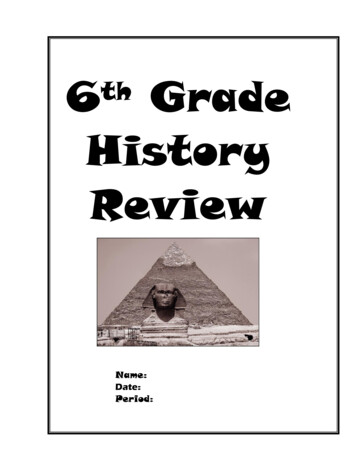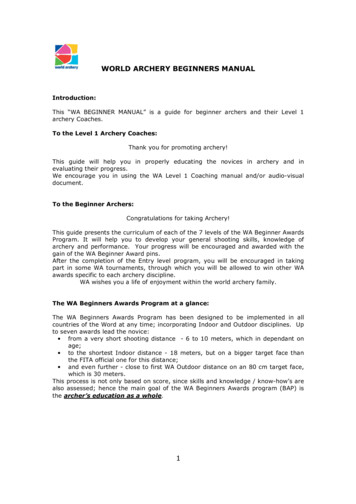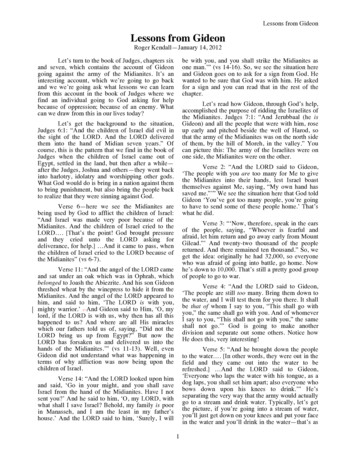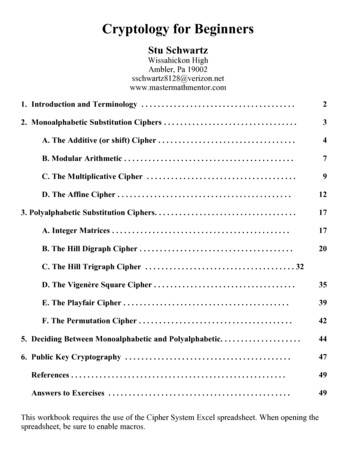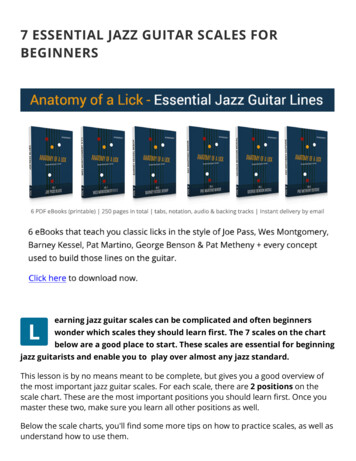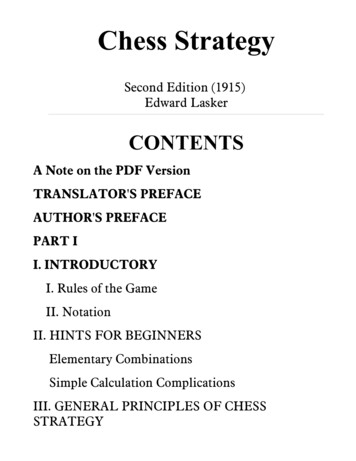
Transcription
Introduction to TorahBeginners Lessons in Scriptural InterpretativeMethods ByRabbi Edward L. Nydle (Levi bar Ido)B’nai AvrahamPo Box 556Ottumwa, IA 52501Copyright 20101
Introduction:The true student of Scripture accepts the study of the Torah as a central part of their life. TheWritten Torah (Torah sh’bichtav) has an inexhaustible fertility. No matter how many times onereads the Torah portions, one finds new perceptions and insights that had escaped their previousstudy. Thus, the students understanding of the Scripture increases with each year of Torah study(each weekly Torah section is called a parasha). Reading these same sections each week createsa sense of global community and connects us with the Torah community throughout the ages. Aswe read the text, we touch upon spirituality and a consciousness of every dimension of thewritings. 2Tim. 2:15 Study to shew thyself approved unto Elohim, a workman that needeth not tobe ashamed, rightly dividing the word of truth.This easy lesson book is my attempt to share with other Truth seekers the various methods ofTorah interpretation. Hopefully, this book will help the experienced student and the person newto the Torah to discover the beauty and depth of the Torah. Their studies will become exciting asthey discover new inner meanings of the text. Studying the Torah is not so much about coming tobinding conclusions, but rather about exploring the possible novel interpretations and insights bythe student.These are keys to interpretation used by the sages and rabbis for centuries. This book is by nomeans an exhaustive handbook of Scripture study methods, some have been intentionally left outand others I have yet to learn in my lifetime. These “keys” can be used to express the beauty ofthe words of the text and speak to each of us in all their profundity. As students and scholars, wedo not seek to define one precise or accurate interpretation, but to mine the text for its riches ithas to offer us. This allows for multiple meanings for one verse or section. The Scriptures are themost read “Book”, yet the most misinterpreted.May the Creator bless you in your study of His Torah.Edward Lewis Nydle (Levi bar Ido) Rabbi-B’nai Avraham2
Beginners Torah Lesson # 1:How to Study the TorahStudents who are new to the study of the Torah need some fundamental principles to helpthem how to properly study and interpret the Torah. Proper Torah study will help them tounderstand the mitzvoth1 in the Torah and their proper application in our everyday lives. Let mehelp you get started in your studies by giving you a few pointers in learning Torah that will makea world of difference. Hopefully, these beginner lessons will prevent you from falling into thetrap of misinterpreting word meanings, verses, and various texts.No communication, be it written or oral, verbal or nonverbal, can be understood withoutinterpretation. We often interpret the communication without even being aware of how we cameto that interpretation and understanding. We interpret words, gestures, how something is said,and even silence. As a written form of communication, the Torah must be interpreted in order tounderstand it. Therefore, we have to know the basic rules of interpretation in order not tomisunderstand the Torah and to understand what it really says. Misinterpretation bringsmisunderstanding. Misunderstanding brings erroneous doctrine and Halakah.2The Torah speaks to modern man. It is not an outdated book of fairy tales and historicalaccounts. It is eternal and is intended to speak Truth to us, as well as the generations that havegone before. The Torah is not a black book of “rules” that define good and evil. Rather, it isintended to serve as a blueprint for living as instructions for man to reach his highest potential. Itserves as a connection to the ten dimensions of the Endless Light of the Creator and removesdarkness that try to come into our lives. “The ultimate purpose of the Torah (Chumash) is to bring about its own end, toterminate our very need of it.” Rav Philip Berg3We will assume everyone reading these lessons agree upon the Divine Source of the Torah andunderstand that YHWH gave the Torah to Moshe and Yisrael at Mt.Sinai. Therefore, it beingfrom Above, every jot and tittle must be taken seriously. The Sages teach us that every passageof the Torah has 70 facets, referring to the 70 members of the ancient Sanhedrin, whose purposewas to interpret the law. The Torah has many levels of intended meaning to the reader.1The commandments found in the TorahThe way of walking out the Torah commandments.3The true meaning of the End of Days is not a war to end all wars, but rather a quantum change in the soul of man,known as the final redemption or transformation of all mankind.23
Also, interpretation of the Torah requires that one must have a deep respect for the significanceof every word and phrase in the text. YHWH has placed in the Torah everything that the studentneeds to read in order to understand the text! It is our job to dig deep within the text to find whatthe Creator is saying.The ancient rabbis have set up four categories of interpretation of the Torah called PDRS orPaRDeS which means -paradise. P’shat, the plain simple ,literal meaning of the text Drash, the homiletic meaning (from this MiDrash) Remez , the hidden or esoterical meaning Sod, the hidden, mysterious, Kabbalistic meaningP’shat is the basic meaning of a text. No Scriptural interpretation EVER abandons its P’shatPlain Sense! This means that NO MATTER WHAT OTHER INTERPRETIVE MODES AREAPPLIED TO THE TEXT, THE TEXT ALWAYS RETAINS ITS PLAIN SENSE AND HASTO BE RECKONED WITH IN THAT MANNER! However, even P’shat has several levels ofinterpretation.This means we must apply the rules of grammar, language, compositional syntax, history,culture, geography, and just plain common sense to the text we are studying. Remember thatinterpretation strives for simplicity as its aim of understanding. The simple interpretation ispreferred over the more complex one. An interpretation that resolves several difficulties raisedby the text has a ring of truth to attach to it.The starting point in ALL Scriptural interpretation is to know WHAT the text is saying. Thisseems obvious! But yet knowing what every word or sentence means is not so obvious. Thatmeans that the students HAVE TO WORK FROM THE ORIGINAL HEBREW TEXT.Translations are merely man’s attempt to interpret the text and ALL TRANSLATIONS AREOPEN TO DISPUTE! No translation is “inspired”. This puts the person who only knows Englishat a great disadvantage over the beginning Hebrew student. He is left to the mercy of thetranslators or mistranslators, whichever the case may be. We cannot approach any text casuallybecause we might miss the opportunity of seeing what lies underneath the text. This requiressome knowledge of the Hebrew language.Next, we must consider HOW the text is being said. That means we have to pay attention tothe adjectives, nouns, pronouns, and proper nouns used in a text. We watch for word plays,repetition, word associations, verbal nuances, and the like. We may have to express this verballyto understand the text.4
One of the rules of hermeneutics is that we must interpret on the basis of text-in-context. Thatmeans any text must be interpreted and is dependent upon the context within which it is found.Words can change meaning when they exist in different contexts and settings. This means everypart of the passage derives its meaning from its surrounding context. A text out of context is apretext. This is called the Contiguity principal-or deriving clues to the interpretation from theneighboring text, chapter, or book.The Torah or the Scriptures is one unified document. We must also look for similaritiesbetween texts. In order to understand one text of the Torah, one must be familiar with anothersection or the whole of the Torah.There are rare words or phrases that appear in differentsections of the Torah.This help us to link together two seemingly unconnected verses andsections by verbal association within the two texts.I must stress that we are to take a text at face value or the Plain Sense of the text. Too manypeople unfamiliar with the rules of Torah interpretation try to spiritualize or allegorize the all thetexts of the Torah!We have to know if we are dealing with poetry, prophecy, history, songs, or legal laws ormitzvoth. We cannot allegorize a legal section of the Torah. We have to look at the plainmeaning and put ourselves in their shoes AT THE TIME to find the meaning of the text.There is a BIG difference between saying, “This verse MEANS such and such” and “Thisverse can serve as an illustration or principle to teach us about such and such”. By saying thefirst we are assigning a specific literal meaning to the text, while the latter might help us to cometo an understanding of another text or principle within the Torah. It is so important that weunderstand this rule of Torah interpretation. If we do not apply this rule then we will misinterpretmany of the plain legal aspects of Torah commands that YHWH has given us and try tospiritualize them away .We can only arrive at the literal meaning of the text after careful study ofthe text and its original YHWH inspired meaning. However, we can say it serves as anillustration of a principle within Scripture without declaring it to be the original meaning of thetext. This is done especially when we try to bring things into our lives as practical application.PRACTICAL APPLICATION IS THE LAST STEP OF TEXTUAL INTERPRETATION! THISIS WHERE WE BECOME DISHONEST IN THE INTERPRETATION OR HANDLING OFTHE TEXT AND THE TORAH. WE CANNOT ASSIGN MEANINGS TO A TEXT ORCOMMAND THAT ARE NOT THERE IN THE ORIGINAL COMMANDMENT.5
Let me say this about practical application- we MUST look to see HOW they applied thiscommandment in ancient Israel, and how they understood the text. We also need to look at HOWTHE JEWISH PEOPLE APPLY THIS COMMAND TODAY! They do not have all thingscorrect; however, they DO HAVE THE MAJORITY OF THINGS RIGHT! They have preservedthe Torah for us for thousands of years! We read in the Brit Chadasha:4 “What then is the advantage of the Yehudite, or what is the value of circumcision?MUCH in every way! Because firstly indeed that THEY were entrusted with the WORDSOF ELOHIM. Romans 3:1-2Remember that the Torah scroll was not written with any chapters and verses. Sentences are notmarked off in the original. These are Medieval “Christian” additions to the Scriptures andsometimes tend to muddy the waters more than they help! Sometimes they break up wholethoughts by the chapter divisions. In the Hebrew Scroll there are not any forms of punctuation orvowel pointings either. These were all added later by the Oral Massoretic tradition. So, wecannot always trust the vowel pointing to know the correct Hebrew word or pronunciation of theword. Many texts were changed by the Massoritics to hide the verses and words pointing toYahshua as the Mashiach5. One vowel point can change the meaning of a whole verse!We have to become experts of the text! We have to study, study, and study! We have tofamiliarize ourselves with all the tools of the student of the Scriptures! We have to becomeardent users of the various Concordances, Dictionaries, Encyclopedias, Commentaries, andvarious works of the Sages. Good reference materials are a MUST for the serious student! AWORD OF CAUTION: we have to be aware of prejudices of the writers and compilers ofvarious works.We must also rely upon the Ruach HaKodesh (Set-apart Spirit) to be our teacher of the Torah.Tehillim 119:18 says: “Open my eyes, that I might behold the wonderful things from Your Torah.”Rebbe Mashiach Yahshua said, “But the Helper, the Set-Apart Spirit, whom the Father shallsend in My Name, He shall teach you all, and remind you of all I said to you.” Yochanan (John)15:26 the Scriptures.45The Renewed CovenantMessiah6
Look for passages of the Torah when reading the Brit Chadasha (Renewed Covenant). Thiswill help the Ruach to show you how the early Body of Messiah interpreted the passage, and alsohow they practiced the mitzvot. It is essential for us to see the spirit behind the commandment tounderstand WHY YHWH gave it to Yisrael in the first place at Mt.Sinai. This means we have toknow both the letter of the law and the spirit of the law. Each mitzvah has a literal and spiritualmeaning. YHWH wants us to know and observe both!Study is not an end in itself. We have to become doers of the Word also. There comes a timewhen we have to apply the teachings we are learning to our lives in order to rise up and becomeNazarene Yisrael! Every Torah teacher must encourage his students to practice the Torah andapply what they are learning.Last of all: WE MUST ALL STAY TEACHABLE AND BE WILLING TO CHANGE OUROPINIONS WHEN SCRIPTURE PROVES US TO BE WRONG!None of us have all the TRUTH.We must be willing to look at different teachings andviewpoints to see if they have any validity based upon the Scriptural proof presented to us.I hope this first short introductory lesson on the Torah has been helpful to you as a student ofthe Word of YHWH. May He grant you Wisdom, Understanding and Knowledge.Students Notes:7
Beginners Torah Lesson #2:Understanding the MitzvotThis is the second lesson of the beginner’s Torah series .In this lesson we are going to studyhow to understand the mitzvah or mitzvot (pl.) of YHWH in the Torah.The word –MITZVAH-means a command that comes from YHWH that requires an action inorder to fulfill it. Perhaps you have recognized the word from the word –Bar Mitzvah- meaning“son of the commandment”. The source of commandments is found in the Torah or the first fivebooks of the Scriptures known as the Five Books of Moshe. All the commandments are found inthe Torah, although they are not numbered or even specified in the Torah. We have to look to therabbinical interpretation of the Torah to find the enumerat
Let me help you get started in your studies by giving you a few pointers in learning Torah that will make a world of difference. Hopefully, these beginner lessons will prevent you from falling into the trap of misinterpreting word meanings, verses, and various texts.



